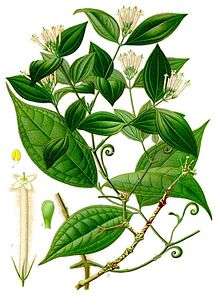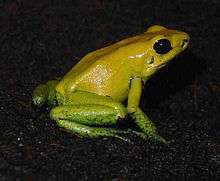Arrow poison
Arrow poisons are used to poison arrow heads or darts for the purposes of hunting and warfare. They have been used by indigenous peoples worldwide and are still in use in areas of South America, Africa and Asia. Notable examples are the poisons secreted from the skin of the poison dart frog, and curare (or 'ampi'), a general term for a range of plant-derived arrow poisons used by the indigenous peoples of South America.[1]
Poisoned arrows have featured in mythology, notably the Greek story of Heracles slaying the centaur Nessus using arrows poisoned with the blood of the Lernaean Hydra. The Greek hero Odysseus poisons his arrows with hellebore in Homer's Odyssey. Poisoned arrows also figure in Homer's epic about the Trojan War, the Iliad, in which both Achaeans and Trojans used toxic arrows and spears.[2] Baldr's death in the Norse myths features poison arrows. The modern terms "toxic" and "toxin" derive from the ancient Greek word for "bow", toxon, from Old Persian *taxa-, "an arrow".[3][4][5]
Poison arrows were used by real peoples in the ancient world, including the Gauls, ancient Romans, and the nomadic Scythians and Soanes. Ancient Greek and Roman historians describe recipes for poisoning projectiles and historical battles in which poison arrows were used. Alexander the Great encountered poisoned projectiles during his conquest of India (probably dipped in the venom of Russell's viper) and the army of the Roman general Lucullus suffered grievous poison wounds from arrows shot by nomads during the Third Mithridatic War (1st century BC).[2] Ferdinand Magellan was killed in the Philippines during the Battle of Mactan when he was struck in the leg by a poisoned arrow.[6]
The use of poisoned arrows in hunting and warfare by some Native Americans has also been documented.[7]
Over the ages, Chinese warfare has included projectiles poisoned with various toxic substances.[8]
Varieties
Arrow poisons around the world are created from many sources:
Plant based poisons

- Curare is a generic term for arrow poisons that contain tubocurarine, curarine, quinine, protocurarine and related alkaloids. Most frequently it is derived from the bark of Strychnos toxifera, S. guianensis (family Loganiaceae), Chondrodendron tomentosum or Sciadotenia toxifera (family Menispermaceae). Curare is a competitive antagonist that blocks nicotinic acetylcholine receptors on the post synaptic membrane of the neuromuscular junction. It is a muscle relaxant that causes death by paralyzing the respiratory system, resulting in asphyxiation.
- In Africa arrow poisons are made from plants that contain cardiac glycosides, such as Acokanthera (possessing ouabain), oleander (Nerium oleander), milkweeds (Asclepias), or Strophanthus, all of which are in the Apocynaceae family.[1] Inee or onaye is a poison made from Strophanthus hispidus, which contains the cardiac glycoside strophanthin. It is used in sub-Saharan West Africa, particularly in the areas of Togo and Cameroon.[9]
- Poisoned arrows are used widely in the jungle areas of Assam, Burma and Malaysia. The main plant sources for the poisons are members of the Antiaris, Strychnos and Strophanthus genera. Antiaris toxicaria for example, a tree of the mulberry and breadfruit family, is commonly used on Java and its neighbouring islands. The sap or juice of the seeds is smeared on the arrowhead on its own or mixed with other plant extracts.[10] The fast-acting active ingredient (either antiarin, strychnine or strophanthin) attacks the central nervous system causing paralysis, convulsions and cardiac arrest.[10]
- Several species of Aconitum or "aconite" have been used as arrow poisons, which belong to the buttercup family, Ranunculaceae. The Minaro in Ladakh use A. napellus on their arrows to hunt Siberian ibex; they were in use recently near lake Issyk Kul in Kyrgyzstan.[11] The Ainus in Japan used a species of Aconitum to hunt brown bear.[12] It was also used by the Butias and Lepchas in Sikkim and Assam.[13][14] The Chinese used Aconitum poisons both for hunting[15] and warfare.[16]
- The Caribs of the Caribbean used poisons made from the sap of the manchineel tree (Hippomane mancinella) or sandbox tree (Hura crepitans), both members of the spurge family, Euphorbiaceae.[17]
- Some Native Americans used poisons from the golden poppy (Eschscholzia californica), the Cassava (Manihot esculenta), the bloodroot (Sanguinaria canadensis), Veratrum, and Datura. To make a poisoned arrow from a plant extract the sharp edges of the poisoned arrow were either dipped in the sap of the plant or water in which the plant had been boiled.
Animal-based poisons

- In South America, tribes such as the Noanamá Chocó and Emberá Chocó of western Colombia dip the tips of their blowgun darts in the poison found on the skin of three species of Phyllobates, a genus of poison dart frog. In northern Chocó Department, Phyllobates aurotaenia is used, while P. bicolor is used in Risaralda Department and southern Chocó. In Cauca Department, only P. terribilis is used for dart making. The poison is generally collected by roasting the frogs over a fire, but the batrachotoxins in P. terribilis are powerful enough that it is sufficient to dip the dart in the back of the frog without killing it.
- In the northern Kalahari Desert, the most commonly used arrow poison is derived from the larva and pupae of beetles of the genus Diamphidia. It is applied to the arrow either by squeezing the contents of the larva directly onto the arrow head, mixing it with plant sap to act as an adhesive, or by mixing a powder made from the dried larva with plant juices and applying that to the arrow tip. The toxin is slow attacking and large animals can survive 4–5 days before succumbing to the effects.[18]
- In the United States, Native American tribes used venomous reptiles to provide the poisons required. In the Southwest United States, the Gila monster, being one of the only two venomous lizards.
There is evidence of Pacific Island cultures using poison arrow and spear tips. An account from Hector Holthouse's book "Cannibal Cargoes" P.141 (on the subject of the Australian Pacific Island Labour Trade) describes a canoe, resting on forks in the sand; within the canoe the body of a man rotting in the sun. The unsealed canoe allowing the putrefaction to collect in a knotched shallow bowl in which arrow heads and spear tips are soaked. Wounds with these weapons caused tetanus infection.
Preparation
The following 17th-century account describes how arrow poisons were prepared in China:
- "In making poison arrows for shooting wild beasts, the tubers of wild aconitum are boiled in water. The resulting liquid, being highly viscous and poisonous, is smeared on the sharp edges of arrowheads. These treated arrowheads are effective in the quick killing of both human beings and animals, even though the victim may shed only a trace of blood."[15]
Native American tribes would agitate the snake or lizard until it repeatedly struck into the spoiled meat or liver of an animal, impregnating it with its toxin. The tips of arrows or the blowgun darts were then dipped into the poisoned meat.
See also
- Blowgun
- Bushman poison (disambiguation)
- Fukiya Japanese blowgun
- Loire style blowgun (French page)
References
- 1 2 "Curare". Archived from the original on 10 August 2006. Retrieved 2006-08-09.
- 1 2 Mayor, Adrienne (2009). Greek Fire, Poison Arrows and Scorpion Bombs: Biological and Chemical Warfare in the Ancient World (Revised ed.). The Overlook Press. ISBN 978-1-59020-177-0.
- ↑ http://www.aarc.org/resources/biological/history.asp, A History of Biological Warfare from 300 B.C.E. to the Present, Retrieved August 7, 2012.
- ↑ http://www.etymonline.com/index.php?term=toxic, Online Etymology Dictionary, Retrieved August 7, 2012.
- ↑ http://www.thefreedictionary.com/toxic, The Free Dictionary, Retrieved August 7, 2012.
- ↑ "Magellan killed in the Philippines - Apr 27, 1521 - HISTORY.com". Retrieved 20 October 2016.
- ↑ Jones, David E (2007). Poison Arrows: North American Indian Hunting and Warfare. University of Texas Press. ISBN 978-0-292-71428-1.
- ↑ Sawyer, Ralph D (2007). The Tao of Deception: Unorthodox Warfare in Historic and Modern China. Basic Books. ISBN 978-0-465-07205-7.
- ↑ "Definition of inee". Webster's International Dictionary. 1913. Archived from the original on 2012-02-16. Retrieved 2006-08-09.
- 1 2 "Poisoned arrows". Victoria and Albert Museum. Archived from the original on 25 August 2006. Retrieved 2006-08-10.
- ↑ St. George, George (1974). Soviet Deserts and Mountains. Amsterdam: Time-Life International.
- ↑ Peissel, Michel (1984). The Ants' Gold: The Discovery of the Greek El Dorado in the Himalayas. London Harvill Press. pp. 99–100.
- ↑ Hooker, Joseph Dalton (1854). Himalayan Journals or Notes of a Naturalist. London: John Murray. p. 168. Retrieved 2006-09-17.
- ↑ Hutton, J. H. (July 1924). "The occurrence of the Blow-Gun in Assam". Man. Royal Anthropological Institute of Great Britain and Ireland. 24: 106.
- 1 2 Song, Yingxing; Sun, Shiou-chuan; Sun, E-tu Zen (1996). Chinese Technology in the Seventeenth Century: T'ien-kung K'ai-wu. Mineola, New York: Dover Publications. p. 267. ISBN 978-0-486-29593-0.
- ↑ Chavannes, Édouard. “Trois Généraux Chinois de la dynastie des Han Orientaux. Pan Tch’ao (32-102 p.C.); – son fils Pan Yong; – Leang K’in (112 p.C.). Chapitre LXXVII du Heou Han chou.”. 1906. T’oung pao 7, pp. 226-227.
- ↑ Jones, David E (2007). Poison Arrows: North American Indian Hunting and Warfare. University of Texas Press. p. 29. ISBN 978-0-292-71428-1. Retrieved 2009-01-24.
- ↑ "How San hunters use beetles to poison their arrows". Iziko Museums of Cape Town. Archived from the original on 2006-05-06. Retrieved 2006-08-09.